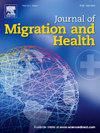Global burden of cancer among refugees: A systematic review and meta-analysis
IF 2.9
Q1 PUBLIC, ENVIRONMENTAL & OCCUPATIONAL HEALTH
引用次数: 0
Abstract
Background
Refugees are a distinct group of migrants with a variety of cancer risks through cumulative exposures from their country of origin, migration process, and host countries. We conducted a comprehensive systematic synthesis of the epidemiological burden (incidence, prevalence, and mortality) of overall and site specific cancers among refugee populations globally.
Method
We systematically searched in OVID (Medline, Embase), CINAHL, and Scopus for studies reporting cancer prevalence, incidence, or mortality data among refugees globally from database inception to December 15, 2023. We screened for eligible studies using Covidence®. We applied a random-effects model to estimate the pooled proportions of site-specific cancer proportions using R software.
Result
Twenty-nine studies from 12 host countries comprising 561,850 refugees, mainly from Syria and Iraq were included. The pooled proportions for commonly reported site-specific cancer among refugee cancer patients were breast cancer (25.4% (95% CI: 20.3%, 30.4%)), lung cancer (4.8% (95% CI: 3.9%, 5.6%)), leukaemia (16.9% (95% CI: 8.2%, 25.6%)), and central nervous system (CNS) cancer (7.0% (95% CI: 5.3%, 8.7%)) respectively. Studies also reported a higher cervical cancer incidence among female refuges and higher liver cancer mortality among male refugees than non-refugee populations.
Conclusion
Although the existing evidence is limited, this review highlights a notable cancer burden among refugees, with higher incidence and mortality for certain cancers such as cervical and liver cancer among refugees than non-refugees. Targeted practical initiatives in ensuring optimal cancer continuum of care for refugees with cross-disciplinary collaboration are needed.
难民的全球癌症负担:系统回顾和荟萃分析
难民是一个独特的移民群体,由于其原籍国、移民过程和东道国的累积暴露,他们面临各种癌症风险。我们对全球难民人口中总体和特定地点癌症的流行病学负担(发病率、患病率和死亡率)进行了全面系统的综合。方法系统检索OVID (Medline, Embase)、CINAHL和Scopus,检索从数据库建立到2023年12月15日全球难民癌症患病率、发病率或死亡率数据的研究。我们使用covid®筛选符合条件的研究。我们使用R软件应用随机效应模型来估计部位特异性癌症比例的汇总比例。结果共纳入来自12个收容国的29项研究,涉及561,850名难民,主要来自叙利亚和伊拉克。难民癌症患者中常见的部位特异性癌症的合并比例分别为乳腺癌(25.4% (95% CI: 20.3%, 30.4%),肺癌(4.8% (95% CI: 3.9%, 5.6%)),白血病(16.9% (95% CI: 8.2%, 25.6%))和中枢神经系统(CNS)癌症(7.0% (95% CI: 5.3%, 8.7%))。研究还报告说,女性难民的宫颈癌发病率高于非难民人口,男性难民的肝癌死亡率高于非难民人口。尽管现有证据有限,但本综述强调了难民中显著的癌症负担,难民中某些癌症(如宫颈癌和肝癌)的发病率和死亡率高于非难民。需要采取有针对性的实际行动,通过跨学科合作,确保为难民提供最佳的癌症连续治疗。
本文章由计算机程序翻译,如有差异,请以英文原文为准。
求助全文
约1分钟内获得全文
求助全文
来源期刊

Journal of Migration and Health
Social Sciences-Sociology and Political Science
CiteScore
5.70
自引率
8.70%
发文量
65
审稿时长
153 days
 求助内容:
求助内容: 应助结果提醒方式:
应助结果提醒方式:


